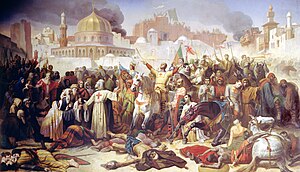
Back Belagerung von Jerusalem (1099) ALS حصار القدس (1099) Arabic Yerusəlimin mühasirəsi (1099) Azerbaijani قودس موحاصیرهسی (۱۰۹۹) AZB Обсада на Йерусалим (1099) Bulgarian জেরুসালেম অবরোধ (১০৯৯) Bengali/Bangla Setge de Jerusalem (1099) Catalan Къудс-ГӀалин гуо лацар (1099) CE Obléhání Jeruzaléma (1099) Czech Belagerung von Jerusalem (1099) German
| Siege of Jerusalem (1099) | |||||||||
|---|---|---|---|---|---|---|---|---|---|
| Part of the First Crusade | |||||||||
 Taking of Jerusalem by the Crusaders (1847) by Émile Signol | |||||||||
| |||||||||
| Belligerents | |||||||||
| Crusaders | Fatimid Caliphate | ||||||||
| Commanders and leaders | |||||||||
| Strength | |||||||||
12,200–13,300 soldiers[1][2]
| Total unknown[4] | ||||||||
| Casualties and losses | |||||||||
| ~3,000 killed and wounded[7] |
Entire garrison killed 3,000–70,000 Muslims and Jews massacred[8] | ||||||||
Site of the siege relative to the Mediterranean | |||||||||
| Part of a series on |
| Jerusalem |
|---|
 |
The siege of Jerusalem marked the successful end of the First Crusade, whose objective was the recovery of the city of Jerusalem and the Church of the Holy Sepulchre from Islamic control. The five-week siege began on 7 June 1099 and was carried out by the Christian forces of Western Europe mobilized by Pope Urban II after the Council of Clermont in 1095. The city had been out of Christian control since the Muslim conquest of the Levant in 637 and had been held for a century first by the Seljuk Turks and later by the Egyptian Fatimids. One of the root causes of the Crusades was the hindering of Christian pilgrimages to the Holy Land which began in the 4th century. A number of eyewitness accounts of the battle were recorded, including in the anonymous chronicle Gesta Francorum.
After Jerusalem was captured on 15 July 1099, thousands of Muslims and Jews were massacred by Crusader soldiers. As the Crusaders secured control over the Temple Mount, revered as the site of the two destroyed Jewish Temples, they also seized Al-Aqsa Mosque and the Dome of the Rock and repurposed them as Christian shrines. Godfrey of Bouillon, prominent among the Crusader leadership, was elected as the first ruler of Jerusalem.
- ^ France 1994, p. 3
- ^ Asbridge 2004, p. 308
- ^ France 1994, pp. 346–350
- ^ a b France 1994, p. 343
- ^ Asbridge 2004, p. 300
- ^ Rubenstein 2011, p. 297
- ^ France 1994, p. 131
- ^ The "massacre" at the sack of Jerusalem has become a commonplace motive in popular depictions, but the historical event is difficult to reconstruct with any certainty. Arab sources give figures of between 3,000 and 70,000 casualties (in Abu Bakr ibn al-Arabi, and in Ibn al-Athir, respectively). The latter figure is rejected as unrealistic as it is very unlikely that the city at the time had a total population of this order; medieval chroniclers tend to substantially exaggerate both troop strength and casualty figures; they cannot be taken at face value naively, and it is less than straightforward to arrive at realistic estimates based on them. For a further study of the Arab accounts see Hirschler, Konrad (2014). The Jerusalem Conquest of 492/1099 in the Medieval Arabic Historiography of the Crusades: From Regional Plurality to Islamic Narrative.
